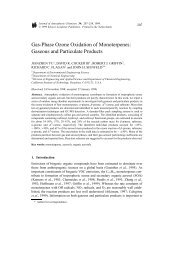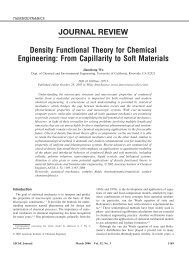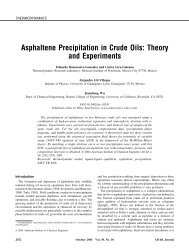DEVELOPMENT OF REVISED SAPRC AROMATICS MECHANISMS
DEVELOPMENT OF REVISED SAPRC AROMATICS MECHANISMS
DEVELOPMENT OF REVISED SAPRC AROMATICS MECHANISMS
Create successful ePaper yourself
Turn your PDF publications into a flip-book with our unique Google optimized e-Paper software.
An indication of the biases in the <strong>SAPRC</strong>-07 aromatics mechanism in simulating the new CSIRO<br />
and UCR EPA chamber data is given in Figure 1, which gives plots of the model error in simulating<br />
amounts of NO oxidation and ozone formation 1 in benzene, toluene, m-xylene and o-cresol - NO x<br />
experiments against initial NO x and initial aromatic / NO x ratios. Different symbols are used for the new<br />
CSIRO and UCR EPA experiments. Figure 1 shows that the mechanism tends to underpredict ozone<br />
formed and NO oxidized in essentially all the new experiments with benzene, toluene and (especially) o-<br />
cresol and indicates a general underprediction bias for m-xylene. There also appears to be a dependence<br />
of the underprediction bias on initial NO x levels in the case of benzene and toluene, and on aromatic/NO x<br />
ratios in the case of toluene and m-xylene.<br />
Not shown on Figure 1 are the results of model simulations of new UCR-EPA chamber<br />
experiments for a number of other aromatic compounds, including other xylene isomers, the<br />
trimethylbenzenes, and compounds for which no chamber data were available when <strong>SAPRC</strong>-07 was<br />
developed, including the ethyltoluene and propylbenzene isomers and other phenolic compounds. It was<br />
found that <strong>SAPRC</strong>-07 had a tendency to underpredict ozone formation rates for many of these other<br />
compounds as well.<br />
Therefore, the new data from the CSIRO and UCR EPA chambers indicate that the <strong>SAPRC</strong>-07<br />
aromatics mechanisms do not give the best fits to the currently available chamber dataset, and need to be<br />
revised to take the new data into account. In addition, the data for benzene and toluene suggest a<br />
dependence of model bias on total NO x levels that cannot be accounted for by any adjustments to the<br />
mechanism using its current formulation. Recent laboratory data (e.g., Nishino et al, 2010; Bethel et al<br />
2000) indicates that there is a dependence of aromatic fragmentation product yields on total NO x levels,<br />
which is not represented in the current mechanism. This is attributed to a competition between the OHaromatic<br />
adduct reacting with O 2 and NO 2 (Koch et al, 2007), with the reaction with O 2 forming the<br />
expected fragmentation products and the reaction with NO 2 at high NO x levels presumably forming other<br />
products. However, according to the laboratory data (Koch et al, 2007), the competing reaction with NO 2<br />
only becomes significant at NO 2 levels greater than ~1 parts per million (ppm), which is much higher than<br />
the NO x levels used in almost all of the experiments in the current evaluation dataset. Therefore, even if<br />
the mechanism were modified to take this aromatic-OH adduct + NO 2 reaction into account it would not<br />
give significantly different simulations of the chamber data unless other changes were made.<br />
To address these problems, in this work we developed a revised version of the <strong>SAPRC</strong>-07<br />
mechanism with the aromatics mechanisms that is updated and readjusted to give better fits to the<br />
chamber data. This modified aromatics version of <strong>SAPRC</strong>-07 is referred to as “<strong>SAPRC</strong>-11” in the<br />
subsequent discussion, though most of the non-aromatic portions of <strong>SAPRC</strong>-11 are the same as <strong>SAPRC</strong>-<br />
07 because a full update of the mechanism is beyond the scope of this project. This <strong>SAPRC</strong>-11 aromatics<br />
mechanism is used as the starting point for a PM-<strong>SAPRC</strong>11 mechanism developed to predict secondary<br />
organic aerosol (SOA) formation from aromatics, as discussed by Carter et al (2012).<br />
1 See the discussion of ∆([O 3 ]-[NO]) model error in the mechanism evaluation section for the definitions<br />
of this and other measures used to evaluate mechanism performance.<br />
6
















